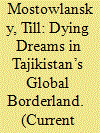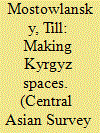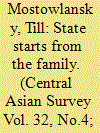|
|
|
Sort Order |
|
|
|
Items / Page
|
|
|
|
|
|
|
| Srl | Item |
| 1 |
ID:
187621


|
|
|
|
|
| Summary/Abstract |
Twenty-five years since the end of Tajikistan’s civil war in 1997, dreams and aspirations of international development and cross-border mobility in the country’s Gorno-Badakhshan Autonomous Province, colloquially called “the Pamirs,” have evaporated. Once the mountainous region was envisaged to have a prosperous postwar future ahead of it, with emerging trade links to China and Afghanistan, substantial funding from international nongovernmental organizations, and support from wealthy Muslim institutions. Today, as the Tajik government mounts a violent campaign to eradicate opposition, people in the Pamirs are surrounded by closed international borders and an ever-shrinking space in which to participate in Tajikistan’s politics and economy.
|
|
|
|
|
|
|
|
|
|
|
|
|
|
|
|
| 2 |
ID:
164899


|
|
|
|
|
| Summary/Abstract |
In this article, I set out to explore the possibility of a shared life between two places in the highlands of Pakistan and Tajikistan—a region dissected by Afghanistan's narrow Wakhan corridor, by present-day nation-state boundaries, by historical divisions between Central and South Asia, and by a former Cold War frontier. Moving away from a take on conviviality as specifically tied to urban spaces and face-to-face encounters, I attempt to trace the processes that determine the coming and going of shared modes of being. In doing so, I first situate the two places—Karimabad and Khorog—in their respective post-Cold War borderlands and point to their historically ambivalent status as ‘marginal’ places at the frontier, culturally diverse ‘hubs’, and sites of globalization. Then I analyse the historical build-up—material and ideological—that led to the establishment of specific forms of connection and disconnection between the two places. In the last part of the article, I discuss how people in and from Karimabad and Khorog seek out opportunities to attain shared instances of common sociality, which often remain ephemeral and subject to regimes of power. Finally, I argue that the cases of these two ‘marginal hubs’ highlight the importance of looking beyond the conventional ‘imperial centre’ when debating the dynamics that lead people to desire, create, and abandon ties across difference.
|
|
|
|
|
|
|
|
|
|
|
|
|
|
|
|
| 3 |
ID:
115815


|
|
|
|
|
| Publication |
2012.
|
| Summary/Abstract |
In the past decade local scholars in Murghab, Tajikistan's easternmost district, have published several books in Kyrgyz on the history and culture of the Eastern Pamirs. In their work, the authors address the region's predominantly Kyrgyz population by emphasizing the 'kyrgyzness' of the Eastern Pamirs, which they refer to as Sarykol. The results of these local studies reverberate widely on the ground and have become integrated into everyday interaction. As a consequence, not only the region's history and culture, but also its territory, are perceived through an increasingly ethnicized lens. This paper seeks to explore local history as a way of appropriating space. Following Henri Lefebvre (1974), local history can be defined as an ethno-spatial practice that emphasizes ethnicity. Through an analysis of five works on local history and culture and their embedding in an ethnographic context, this article provides evidence for the significance of local studies in 'kyrgyzizing' space. It also demonstrates, moreover, that international non-governmental organizations, through their funding of such research, are entangled with globalized visions of culture, tradition and ethnicity.
|
|
|
|
|
|
|
|
|
|
|
|
|
|
|
|
| 4 |
ID:
126037


|
|
|
|
|
| Publication |
2013.
|
| Summary/Abstract |
Based on anthropological fieldwork between 2008 and 2011, this article focuses on how people in Tajikistan's eastern Pamirs conceptualize well-being through the establishment of peace and harmony. An exploration of the interactional use of the terms 'peace' and 'harmony' in Kyrgyz and Tajik (tynchtyk, yntymak, tinji, and vahdat) makes manifest that the meanings of these terms are connected to the fields of 'family', 'leadership', and 'state'. Basing their reasoning on the officially promoted analogy between family and state, people in the eastern Pamirs distinguish between social spaces that are related to well-being and those that are not. As a factor of distinction, and crucial to the establishment of peace and harmony, the moral quality of leadership plays an important role. Positive experiences of such leadership as balanced and morally pure are mainly identified and witnessed within families and neighbourhoods and only occasionally in state institutions. This discrepancy raises the question of where to locate boundaries between good and bad, moral and immoral, harmonious and conflictual. Thus, this article contributes not only to the study of local concepts of well-being in Central Asia but also to the study of local concepts of 'ill-being' which challenge them.
|
|
|
|
|
|
|
|
|
|
|
|
|
|
|
|
|
|
|
|
|